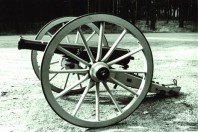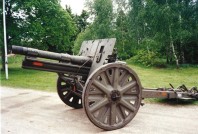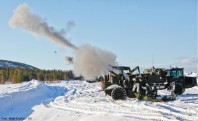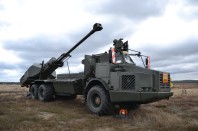History of Artillery
18th century
Our artillery was organized in a single unit, the Royal Artillery Regiment. The sub-units were located from Finland in the north to present-day Germany in the south. The artillery guns fired at an enemy could be seen in the guns and were connected to the commander of the entire army with the help of ordinances, flag signals or signal rockets. The figures were preloaded and the normal shot distance was approx. 300-500 m.The figures were pulled by horses while the staff went behind, but in the vicinity of the enemy by the crew or by special so-called action horses. In 1794, the artillery was organized into four artillery regiments, named after the royal title: Svea, Göta, Wendes and the Finnish artillery regiments.
19th century
At the beginning of the 19th century we left Finland (1809) and Germany (1814). Norway became a union with Sweden in 1814. The artillery could be transported with the staff on the left horses and on the so-called performer, which was called riding artillery or on all the horses in the team, which was called riding artillery. Experiences from the war against Napoleon led to the deployment of a new artillery system, the "Royal Rocket Corps", which could launch rockets with different effects. The artillery was still firing at an enemy that could be seen and the connection with the army chief was as before. The infantry's muskets, with round bullets, were now exchanged for a ribbed weapon, which meant that the now elongated bullet, through its rotation, could go further and thus hit the artillerymen at the pieces. In 1863 a ribbed, but preloaded artillery system was introduced. To increase the rate of fire, rear charging was introduced in 1881.
20th century
The speed of fire was largely due to the fact that you had to move the piece forward after each shot, before you could shoot the next.
To get rid of the recoil, they tried to dampen it with rubber gaskets, coil springs etc. The solution we still use is to dampen and restore the position of the barrel with the help of liquids and gases contained in separate cylinders, attached to the barrel. Our first piece with this system was 7.5cm cannon w / 02.
The experiences from the Second World War, meant that you had to shoot further than you saw from the play, which is why special fire conductors were introduced.
In order to be able to raise the barrel more, the traction device for the piece must be able to be divided so that recoil was made possible at high sets, to reduce the recoil an orifice brake was also introduced, which directed some of the gunpowder gases so that the barrel was braked.
The connection between the fire conductor and the pieces was handled by wire telephony or telegraphy. You could also lead fire from the air with fire conductors in balloons. In the 1940s came 2watt radio that enabled telephony.
Utilizing the muzzle flame on the enemy's artillery, was used by the fire brigade units by measuring the direction to it from several known places (cut-off) and where the lines met was the goal. Using only the sound of the muzzle bang was made by the sound measuring units which placed well-measured microphones and evaluated the time difference, when the sound reached the different microphones. Using both bang and sound was also done, measuring the time from the mouth flame to the sound and thus obtaining the distance, since the place where you were carefully determined, the direction could also be obtained with the help of various instruments. After the war, radar stations arrived which could determine the position of artillery by measuring the upward projectile trajectory, after which the play area could be evaluated. The method used in firing was that the pieces were inlaid and the target had been inlaid. This gave a direction and a distance to the goal. During the Second World War, the fire chief was responsible for the evaluation, but then this took place at the play site, whereby the fire chief only had to state the target. Ammunition used was smoke grenades, light grenades, armored grenades, explosive grenades and grenade launchers. The latter for close combat against infantry. During the 70's, intelligent grenades were added which, with the help of the heat from the target, triggered projectiles against this, e.g. STRIX to 12 cm grenade launcher.
The artillery was mainly horse-drawn to the 1940s and some units into the 1950s. The artillery's first diesel truck was the German Klöcknern, which was delivered in 1942.
In 2010
Artilleriet består av ett enda förband, A9, i Boden. Artillerisystemet kallas 08 eller populärt Archer med artilleripjäsen FH77BWL52. Dessa pjäser ingår i två artilleribataljoner med totalt 24 pjäser. Ytterligare 12 pjäser har införskaffats när Norge sade upp avtalet om inköp av 24 pjäser. Dessa 12 har placerats i förbandsreserven och 2020 kommer vi att få reda på om de sista 12 också kommer att införskaffas.
Eldledning kan ske via eldledare på marken eller från luften via obemannade flygplan (UAV) eller via en artillerilokaliseringsradar som anger platsen för fientligt artilleri till egna enheter. Förutom det konventionella sättet att ange målet med kartreferenser kan man peka ut mål med en laserpekare som granaten styr mot eller så kan granaten vara sk intelligent och själv bestämma var den eller dess stridsdelar skall träffa.
Den ostyrda ammunitionen blir mindre vanlig med hänsyn till skador på civilbefolkningen.
Slagfältets Drottning, Infanteriet har i Sverige nästan försvunnit och slagfältets Konung, Artilleriet har till skillnad från vår omvärld minskat i en omfattning som verkar helt otidsenlig. Detta är ”Ultima Aqua”dvs sista droppen. Archer skall dock förbättra läget med sin avancerade teknik och styrda ammunition med en skottvidd på över 50 km.




